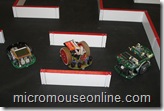 Tonight was the monthly Midlands Club meeting. The club meets on the first Monday of each month at the Technology Innovation Centre in Birmingham. We have been running for a couple of years now and anyone interested in micromouse or robotics in general is welcome to come along for a chat. We had a modest turnout tonight, a good chat about (mostly) mouse related matters and a talk about VHDL from Tony Wilcox. There were a few mice to have a look at and compare notes. It was good to see Andrew Lloyd return after travels afar.
Tonight was the monthly Midlands Club meeting. The club meets on the first Monday of each month at the Technology Innovation Centre in Birmingham. We have been running for a couple of years now and anyone interested in micromouse or robotics in general is welcome to come along for a chat. We had a modest turnout tonight, a good chat about (mostly) mouse related matters and a talk about VHDL from Tony Wilcox. There were a few mice to have a look at and compare notes. It was good to see Andrew Lloyd return after travels afar.
He may be having a revival of micromouse interest and still has at least one fully working mouse to run so we may see him in the summer competition. David Hannaford showed off progress with his mouse, called Lucky, which is looking more confident than ever. Straight-line motion is very smooth and reliable although there are still issues with steering control in the maze. David is confident he will be able to get that under control before the Minos meeting at Royal Holloway in April. I passed Decimus around for people to have a look at. We were able to compare Tony’s Heretic mouse with mine and David’s, all performing similar tasks. Heretic weighs about twice as much as Decimus so it was not too surprising that it was able to win a bit of sumo down a maze corridor. I will have to make some extra weights and then we will see who has the better grip. Michael told us a bit more about his mouse. One day he will bring along something for us all to look at. One day. We were able to get a preview of Tony’s mini-lecture on VHDL. I had always thought of it as interesting but not really necessary in a micromouse when there are so many well equipped processors available. However, as Tony points out, it can be surprisingly difficult to find the exact mix of peripherals that you need all on one processor. Even when you have a good peripheral mix, the exact combination you want always seems to have pin functions shared so that you can’t use them all. the dsPIC has been quite good but has a major shortcoming in the form of only one quadrature encoder. Even then, it shares its pins with two of the analogue inputs. We were shown how easy it is to make things like latches, simple state machines and flexible quadrature decoders and counters. Perhaps a bit of effort would see a universal robot support chip with several channels of quadrature encoding, counters, Acceleration profilers and sophisticated PWM facilities. then, almost any processor with an ADC would do the job of looking after it and all the external functions could readily be memory or register mapped.